Pumping Station Desing - Second Edition by Robert L. Sanks, George Tchobahoglous, Garr M. Jones
Подождите немного. Документ загружается.


Figure
27-2.
An
actual
low
head sewage
pumping
station.
The
station
has one
60-kW
standby
generator,
(a)
Plan;
(b)
section A-A. Find
10
blunders before
looking
at
the
answers
in
Appendix
D.
Figure
27-1.
A
composite
of
several sewage
pumping
stations. Find
at
least
10
blunders before
looking
at the
answers
in
Appendix
D.
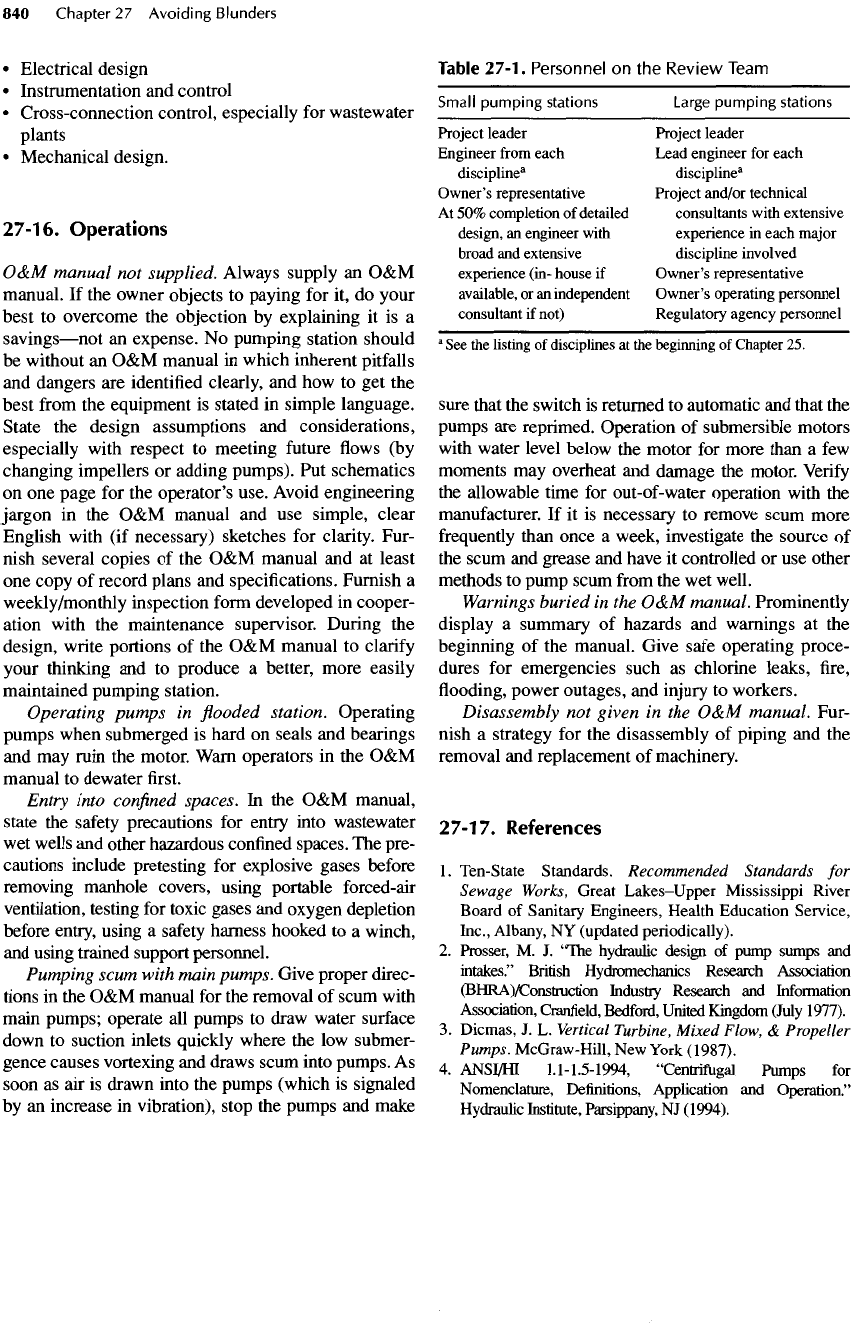
•
Electrical design
•
Instrumentation
and
control
•
Cross-connection control, especially
for
wastewater
plants
•
Mechanical design.
27-16.
Operations
O&M
manual
not
supplied.
Always supply
an O&M
manual.
If the
owner objects
to
paying
for it, do
your
best
to
overcome
the
objection
by
explaining
it is a
savings
—
not
an
expense.
No
pumping station should
be
without
an O&M
manual
in
which inherent pitfalls
and
dangers
are
identified
clearly,
and how to get the
best
from
the
equipment
is
stated
in
simple language.
State
the
design assumptions
and
considerations,
especially with respect
to
meeting
future
flows (by
changing impellers
or
adding pumps).
Put
schematics
on
one
page
for the
operator's use. Avoid engineering
jargon
in the O&M
manual
and use
simple, clear
English with
(if
necessary) sketches
for
clarity. Fur-
nish
several copies
of the O&M
manual
and at
least
one
copy
of
record plans
and
specifications. Furnish
a
weekly
/monthly
inspection form developed
in
cooper-
ation with
the
maintenance supervisor. During
the
design, write portions
of the O&M
manual
to
clarify
your
thinking
and to
produce
a
better, more easily
maintained pumping station.
Operating
pumps
in flooded
station.
Operating
pumps
when submerged
is
hard
on
seals
and
bearings
and
may
ruin
the
motor. Warn operators
in the O&M
manual
to
dewater
first.
Entry
into
confined
spaces.
In the O&M
manual,
state
the
safety
precautions
for
entry into wastewater
wet
wells
and
other hazardous
confined
spaces.
The
pre-
cautions
include pretesting
for
explosive gases before
removing manhole covers, using portable forced-air
ventilation, testing
for
toxic gases
and
oxygen depletion
before
entry, using
a
safety
harness hooked
to a
winch,
and
using trained support personnel.
Pumping
scum with main pumps. Give proper direc-
tions
in the O&M
manual
for the
removal
of
scum with
main pumps; operate
all
pumps
to
draw water
surface
down
to
suction inlets quickly where
the low
submer-
gence causes
vortexing
and
draws scum into pumps.
As
soon
as air is
drawn into
the
pumps (which
is
signaled
by
an
increase
in
vibration), stop
the
pumps
and
make
Table
27-1.
Personnel
on the
Review
Team
Small
pumping
stations
Large pumping
stations
Project
leader Project leader
Engineer
from
each Lead engineer
for
each
discipline
3
discipline
3
Owner's
representative Project and/or technical
At
50%
completion
of
detailed consultants
with
extensive
design,
an
engineer with experience
in
each
major
broad
and
extensive discipline involved
experience (in- house
if
Owner's representative
available,
or an
independent
Owner's
operating personnel
consultant
if
not) Regulatory agency personnel
a
See the
listing
of
disciplines
at the
beginning
of
Chapter
25.
sure that
the
switch
is
returned
to
automatic
and
that
the
pumps
are
reprimed.
Operation
of
submersible motors
with
water level below
the
motor
for
more than
a few
moments
may
overheat
and
damage
the
motor.
Verify
the
allowable time
for
out-of-water operation with
the
manufacturer.
If it is
necessary
to
remove scum more
frequently
than once
a
week, investigate
the
source
of
the
scum
and
grease
and
have
it
controlled
or use
other
methods
to
pump scum
from
the wet
well.
Warnings
buried
in the O&M
manual. Prominently
display
a
summary
of
hazards
and
warnings
at the
beginning
of the
manual. Give
safe
operating proce-
dures
for
emergencies such
as
chlorine leaks,
fire,
flooding,
power outages,
and
injury
to
workers.
Disassembly
not
given
in the O&M
manual. Fur-
nish
a
strategy
for the
disassembly
of
piping
and the
removal
and
replacement
of
machinery.
27-17.
References
1.
Ten-State
Standards.
Recommended Standards
for
Sewage
Works,
Great
Lakes-Upper
Mississippi
River
Board
of
Sanitary
Engineers,
Health
Education
Service,
Inc.,
Albany,
NY
(updated
periodically).
2.
Prosser,
M. J.
"The
hydraulic design
of
pump sumps
and
intakes." British Hydromechanics Research Association
(BHRAyConstruction
Industry Research
and
Information
Association,
Cranfield,
Bedford, United Kingdom (July
1977).
3.
Dicmas,
J. L.
Vertical
Turbine, Mixed
Flow,
&
Propeller
Pumps.
McGraw-Hill,
New
York
(1987).
4.
ANSI/HI
1.1-1.5-1994,
"Centrifugal
Pumps
for
Nomenclature, Definitions, Application
and
Operation."
Hydraulic Institute,
Parsippany,
NJ
(1994).
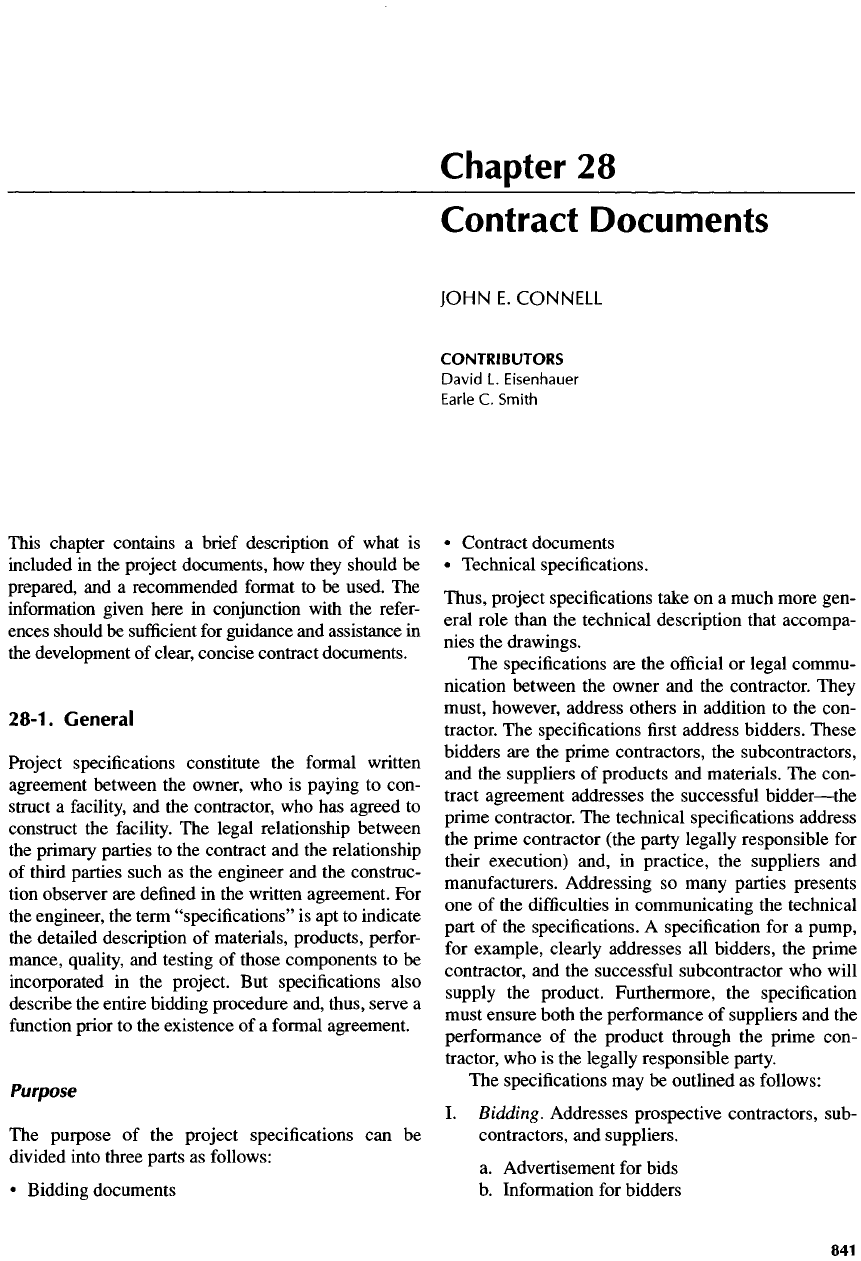
This chapter contains
a
brief description
of
what
is
included
in the
project documents,
how
they should
be
prepared,
and a
recommended
format
to be
used.
The
information
given here
in
conjunction with
the
refer-
ences should
be
sufficient
for
guidance
and
assistance
in
the
development
of
clear, concise contract documents.
28-1. General
Project
specifications constitute
the
formal
written
agreement between
the
owner,
who is
paying
to
con-
struct
a
facility,
and the
contractor,
who has
agreed
to
construct
the
facility.
The
legal relationship between
the
primary parties
to the
contract
and the
relationship
of
third parties such
as the
engineer
and the
construc-
tion observer
are
defined
in the
written agreement.
For
the
engineer,
the
term "specifications"
is apt to
indicate
the
detailed description
of
materials, products, perfor-
mance, quality,
and
testing
of
those components
to be
incorporated
in the
project.
But
specifications also
describe
the
entire bidding procedure and, thus, serve
a
function
prior
to the
existence
of a
formal agreement.
Purpose
The
purpose
of the
project specifications
can be
divided
into three parts
as
follows:
•
Bidding documents
Chapter
28
Contract Documents
JOHN
E.
CONNELL
CONTRIBUTORS
David
L.
Eisenhauer
Earle
C.
Smith
•
Contract documents
•
Technical specifications.
Thus, project specifications take
on a
much more gen-
eral role than
the
technical description that accompa-
nies
the
drawings.
The
specifications
are the
official
or
legal commu-
nication between
the
owner
and the
contractor. They
must,
however, address others
in
addition
to the
con-
tractor.
The
specifications
first
address bidders.
These
bidders
are the
prime contractors,
the
subcontractors,
and
the
suppliers
of
products
and
materials.
The
con-
tract agreement addresses
the
successful
bidder
—
the
prime contractor.
The
technical specifications address
the
prime contractor (the party legally responsible
for
their execution) and,
in
practice,
the
suppliers
and
manufacturers.
Addressing
so
many parties presents
one of the
difficulties
in
communicating
the
technical
part
of the
specifications.
A
specification
for a
pump,
for
example, clearly
addresses
all
bidders,
the
prime
contractor,
and the
successful
subcontractor
who
will
supply
the
product. Furthermore,
the
specification
must
ensure both
the
performance
of
suppliers
and the
performance
of the
product through
the
prime con-
tractor,
who is the
legally
responsible
party.
The
specifications
may be
outlined
as
follows:
I.
Bidding. Addresses prospective contractors, sub-
contractors,
and
suppliers.
a.
Advertisement
for
bids
b.
Information
for
bidders
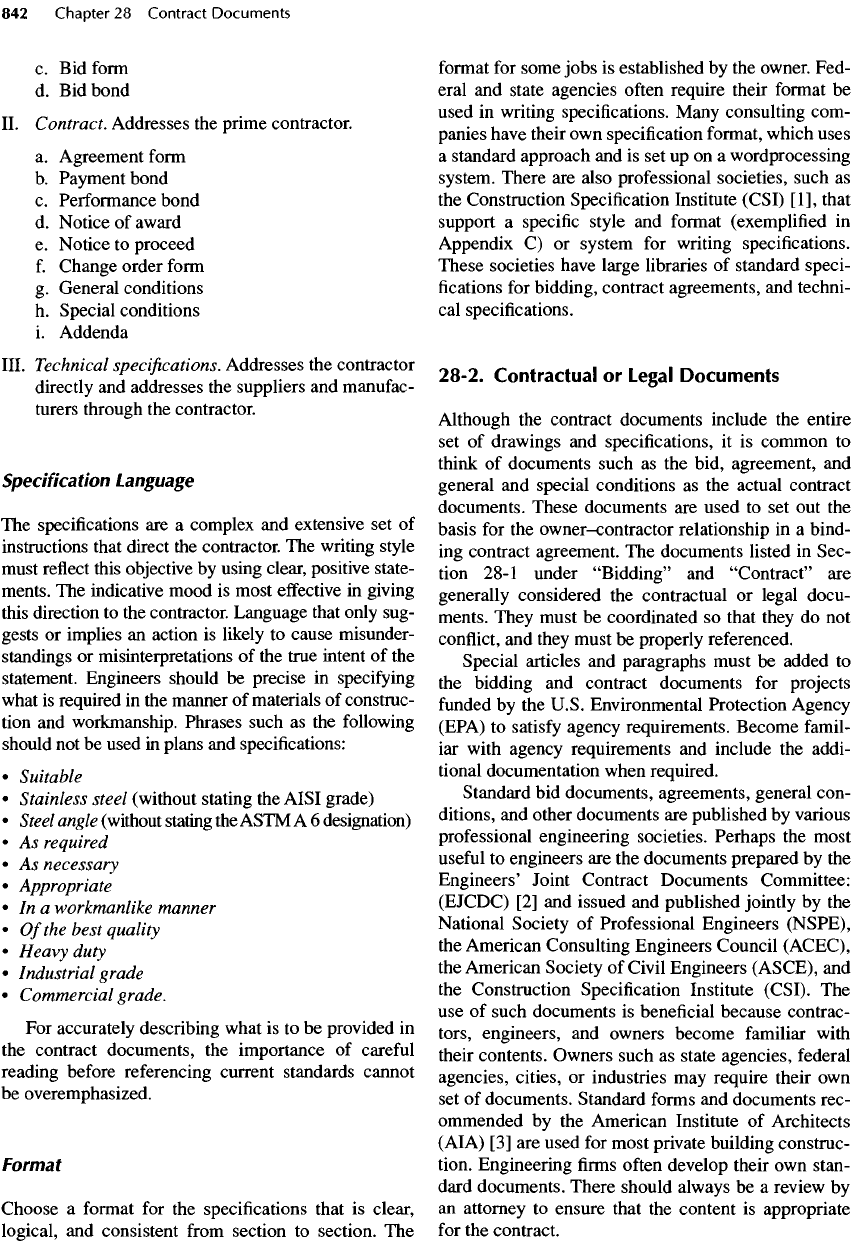
c. Bid
form
d.
Bid
bond
II.
Contract. Addresses
the
prime contractor.
a.
Agreement
form
b.
Payment bond
c.
Performance bond
d.
Notice
of
award
e.
Notice
to
proceed
f
.
Change order
form
g.
General conditions
h.
Special conditions
i.
Addenda
III.
Technical
specifications.
Addresses
the
contractor
directly
and
addresses
the
suppliers
and
manufac-
turers
through
the
contractor.
Specification Language
The
specifications
are a
complex
and
extensive
set of
instructions
that direct
the
contractor.
The
writing style
must
reflect
this objective
by
using clear, positive state-
ments.
The
indicative mood
is
most
effective
in
giving
this
direction
to the
contractor. Language that only sug-
gests
or
implies
an
action
is
likely
to
cause misunder-
standings
or
misinterpretations
of the
true intent
of the
statement. Engineers should
be
precise
in
specifying
what
is
required
in the
manner
of
materials
of
construc-
tion
and
workmanship. Phrases such
as the
following
should
not be
used
in
plans
and
specifications:
•
Suitable
•
Stainless steel (without stating
the
AISI grade)
•
Steel
angle
(without stating
the
ASTM
A 6
designation)
• As
required
• As
necessary
•
Appropriate
• In a
workmanlike manner
•
Of
the
best quality
•
Heavy
duty
•
Industrial grade
•
Commercial grade.
For
accurately describing what
is to be
provided
in
the
contract documents,
the
importance
of
careful
reading before referencing current standards cannot
be
overemphasized.
Format
Choose
a
format
for the
specifications that
is
clear,
logical,
and
consistent
from
section
to
section.
The
format
for
some jobs
is
established
by the
owner. Fed-
eral
and
state agencies
often
require their format
be
used
in
writing specifications. Many consulting com-
panies have their
own
specification format, which uses
a
standard approach
and is set up on a
wordprocessing
system. There
are
also professional
societies,
such
as
the
Construction Specification Institute (CSI) [1], that
support
a
specific
style
and
format (exemplified
in
Appendix
C) or
system
for
writing specifications.
These
societies
have large libraries
of
standard speci-
fications
for
bidding, contract agreements,
and
techni-
cal
specifications.
28-2. Contractual
or
Legal
Documents
Although
the
contract documents include
the
entire
set of
drawings
and
specifications,
it is
common
to
think
of
documents such
as the
bid, agreement,
and
general
and
special conditions
as the
actual contract
documents.
These
documents
are
used
to set out the
basis
for the
owner-contractor
relationship
in a
bind-
ing
contract agreement.
The
documents listed
in
Sec-
tion 28-1 under
"Bidding"
and
"Contract"
are
generally considered
the
contractual
or
legal docu-
ments.
They must
be
coordinated
so
that they
do not
conflict,
and
they must
be
properly referenced.
Special articles
and
paragraphs must
be
added
to
the
bidding
and
contract documents
for
projects
funded
by the
U.S.
Environmental
Protection
Agency
(EPA)
to
satisfy
agency requirements. Become
famil-
iar
with agency requirements
and
include
the
addi-
tional documentation when required.
Standard
bid
documents, agreements, general con-
ditions,
and
other documents
are
published
by
various
professional
engineering
societies.
Perhaps
the
most
useful
to
engineers
are the
documents prepared
by the
Engineers' Joint Contract Documents Committee:
(EJCDC)
[2] and
issued
and
published jointly
by the
National Society
of
Professional Engineers (NSPE),
the
American Consulting Engineers Council (ACEC),
the
American Society
of
Civil Engineers (ASCE),
and
the
Construction Specification Institute (CSI).
The
use of
such documents
is
beneficial because contrac-
tors, engineers,
and
owners become familiar with
their contents. Owners such
as
state agencies, federal
agencies, cities,
or
industries
may
require their
own
set of
documents. Standard forms
and
documents rec-
ommended
by the
American Institute
of
Architects
(AIA)
[3] are
used
for
most private building construc-
tion. Engineering
firms
often
develop their
own
stan-
dard
documents.
There
should always
be a
review
by
an
attorney
to
ensure that
the
content
is
appropriate
for
the
contract.
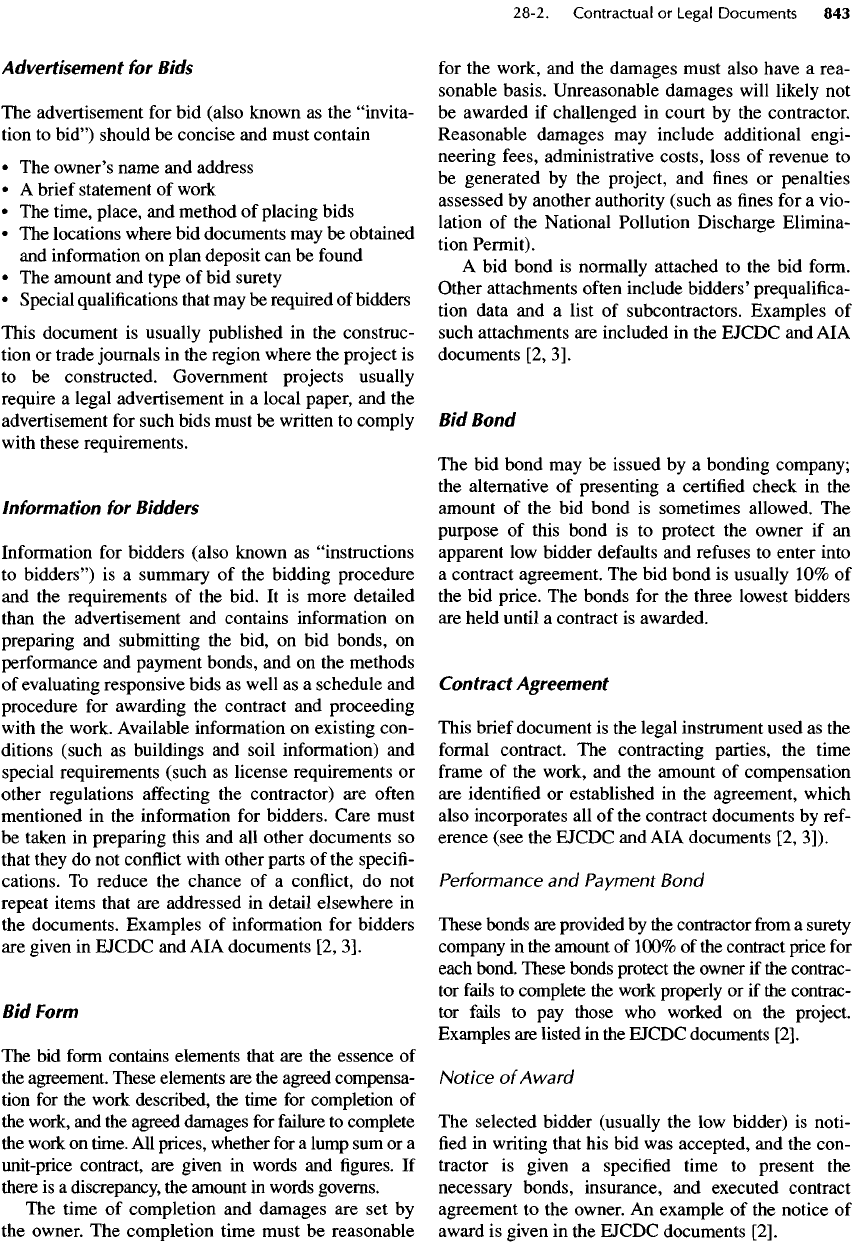
Advertisement
for
Bids
The
advertisement
for bid
(also known
as the
"invita-
tion
to
bid") should
be
concise
and
must contain
• The
owner's name
and
address
• A
brief statement
of
work
• The
time, place,
and
method
of
placing bids
• The
locations where
bid
documents
may be
obtained
and
information
on
plan
deposit
can be
found
• The
amount
and
type
of bid
surety
•
Special
qualifications
that
may be
required
of
bidders
This document
is
usually published
in the
construc-
tion
or
trade journals
in the
region where
the
project
is
to be
constructed. Government projects usually
require
a
legal advertisement
in a
local
paper,
and the
advertisement
for
such bids must
be
written
to
comply
with
these requirements.
Information
for
Bidders
Information
for
bidders (also known
as
"instructions
to
bidders")
is a
summary
of the
bidding procedure
and
the
requirements
of the
bid.
It is
more detailed
than
the
advertisement
and
contains information
on
preparing
and
submitting
the
bid,
on bid
bonds,
on
performance
and
payment bonds,
and on the
methods
of
evaluating responsive bids
as
well
as a
schedule
and
procedure
for
awarding
the
contract
and
proceeding
with
the
work. Available information
on
existing con-
ditions (such
as
buildings
and
soil information)
and
special requirements (such
as
license
requirements
or
other regulations
affecting
the
contractor)
are
often
mentioned
in the
information
for
bidders. Care must
be
taken
in
preparing this
and all
other documents
so
that
they
do not
conflict
with other parts
of the
specifi-
cations.
To
reduce
the
chance
of a
conflict,
do not
repeat items
that
are
addressed
in
detail elsewhere
in
the
documents. Examples
of
information
for
bidders
are
given
in
EJCDC
and AIA
documents
[2,
3].
Bid
Form
The bid
form
contains elements that
are the
essence
of
the
agreement. These elements
are the
agreed compensa-
tion
for the
work described,
the
time
for
completion
of
the
work,
and the
agreed damages
for
failure
to
complete
the
work
on
time.
All
prices, whether
for a
lump
sum or a
unit-price
contract,
are
given
in
words
and figures. If
there
is a
discrepancy,
the
amount
in
words governs.
The
time
of
completion
and
damages
are set by
the
owner.
The
completion time must
be
reasonable
for
the
work,
and the
damages must also have
a
rea-
sonable basis. Unreasonable damages will likely
not
be
awarded
if
challenged
in
court
by the
contractor.
Reasonable damages
may
include additional engi-
neering
fees,
administrative costs, loss
of
revenue
to
be
generated
by the
project,
and fines or
penalties
assessed
by
another authority (such
as fines for a
vio-
lation
of the
National Pollution Discharge Elimina-
tion
Permit).
A
bid
bond
is
normally attached
to the bid
form.
Other attachments
often
include
bidders'
prequalifica-
tion data
and a
list
of
subcontractors. Examples
of
such
attachments
are
included
in the
EJCDC
and AIA
documents
[2,
3].
Bid
Bond
The bid
bond
may be
issued
by a
bonding company;
the
alternative
of
presenting
a
certified check
in the
amount
of the bid
bond
is
sometimes allowed.
The
purpose
of
this bond
is to
protect
the
owner
if an
apparent
low
bidder defaults
and
refuses
to
enter into
a
contract agreement.
The bid
bond
is
usually
10% of
the bid
price.
The
bonds
for the
three lowest bidders
are
held until
a
contract
is
awarded.
Contract
Agreement
This brief document
is the
legal instrument used
as the
formal
contract.
The
contracting parties,
the
time
frame
of the
work,
and the
amount
of
compensation
are
identified
or
established
in the
agreement, which
also incorporates
all of the
contract documents
by
ref-
erence (see
the
EJCDC
and AIA
documents
[2,
3]).
Performance
and
Payment
Bond
These bonds
are
provided
by the
contractor
from
a
surety
company
in the
amount
of
100%
of the
contract price
for
each bond. These bonds protect
the
owner
if the
contrac-
tor
fails
to
complete
the
work properly
or if the
contrac-
tor
fails
to pay
those
who
worked
on the
project.
Examples
are
listed
in the
EJCDC documents
[2].
Notice
of
Award
The
selected bidder (usually
the low
bidder)
is
noti-
fied
in
writing that
his bid was
accepted,
and the
con-
tractor
is
given
a
specified time
to
present
the
necessary bonds, insurance,
and
executed contract
agreement
to the
owner.
An
example
of the
notice
of
award
is
given
in the
EJCDC documents
[2].
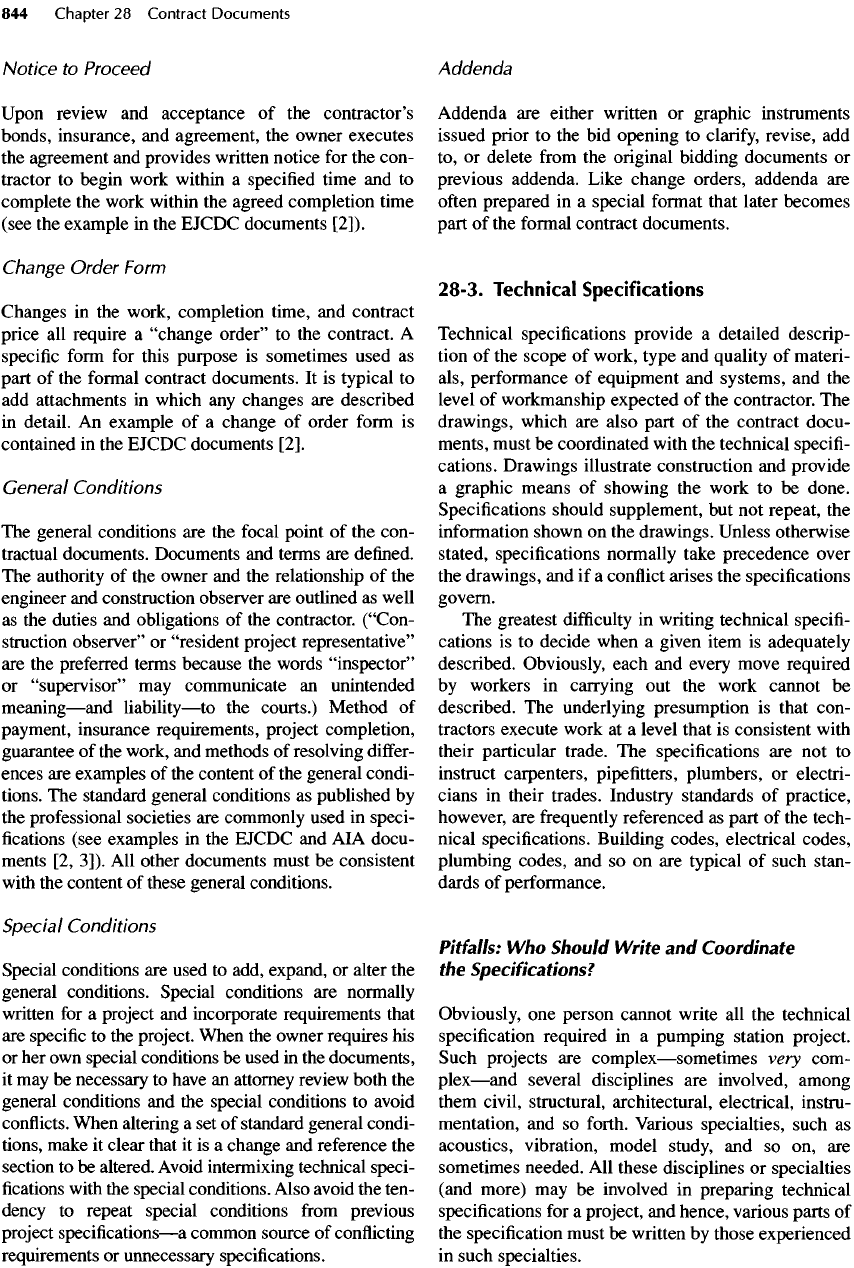
Notice
to
Proceed
Upon
review
and
acceptance
of the
contractor's
bonds, insurance,
and
agreement,
the
owner executes
the
agreement
and
provides written notice
for the
con-
tractor
to
begin work within
a
specified
time
and to
complete
the
work within
the
agreed completion time
(see
the
example
in the
EJCDC documents
[2]).
Change
Order
Form
Changes
in the
work, completion time,
and
contract
price
all
require
a
"change
order"
to the
contract.
A
specific
form
for
this purpose
is
sometimes used
as
part
of the
formal
contract documents.
It is
typical
to
add
attachments
in
which
any
changes
are
described
in
detail.
An
example
of a
change
of
order
form
is
contained
in the
EJCDC documents
[2].
General
Conditions
The
general conditions
are the
focal point
of the
con-
tractual
documents. Documents
and
terms
are
defined.
The
authority
of the
owner
and the
relationship
of the
engineer
and
construction observer
are
outlined
as
well
as
the
duties
and
obligations
of the
contractor.
("Con-
struction
observer"
or
"resident
project representative"
are
the
preferred terms because
the
words
"inspector"
or
"supervisor"
may
communicate
an
unintended
meaning
—
and
liability
—
to
the
courts.) Method
of
payment,
insurance requirements, project completion,
guarantee
of the
work,
and
methods
of
resolving
differ-
ences
are
examples
of the
content
of the
general condi-
tions.
The
standard general conditions
as
published
by
the
professional societies
are
commonly used
in
speci-
fications
(see examples
in the
EJCDC
and AIA
docu-
ments
[2,
3]).
All
other documents must
be
consistent
with
the
content
of
these general conditions.
Special
Conditions
Special conditions
are
used
to
add, expand,
or
alter
the
general conditions. Special conditions
are
normally
written
for a
project
and
incorporate requirements that
are
specific
to the
project. When
the
owner requires
his
or
her own
special conditions
be
used
in the
documents,
it
may be
necessary
to
have
an
attorney review both
the
general conditions
and the
special conditions
to
avoid
conflicts.
When altering
a set of
standard general condi-
tions, make
it
clear that
it is a
change
and
reference
the
section
to be
altered. Avoid intermixing technical speci-
fications
with
the
special conditions. Also avoid
the
ten-
dency
to
repeat special conditions
from
previous
project
specifications
—
a
common source
of
conflicting
requirements
or
unnecessary specifications.
Addenda
Addenda
are
either written
or
graphic instruments
issued
prior
to the bid
opening
to
clarify,
revise,
add
to, or
delete
from
the
original bidding documents
or
previous addenda. Like change orders, addenda
are
often
prepared
in a
special
format
that later becomes
part
of the
formal contract documents.
28-3. Technical Specifications
Technical specifications provide
a
detailed descrip-
tion
of the
scope
of
work, type
and
quality
of
materi-
als, performance
of
equipment
and
systems,
and the
level
of
workmanship expected
of the
contractor.
The
drawings, which
are
also part
of the
contract docu-
ments, must
be
coordinated with
the
technical
specifi-
cations. Drawings illustrate construction
and
provide
a
graphic means
of
showing
the
work
to be
done.
Specifications
should supplement,
but not
repeat,
the
information
shown
on the
drawings. Unless otherwise
stated, specifications normally take
precedence
over
the
drawings,
and if a
conflict
arises
the
specifications
govern.
The
greatest
difficulty
in
writing technical
specifi-
cations
is to
decide when
a
given item
is
adequately
described. Obviously, each
and
every move required
by
workers
in
carrying
out the
work cannot
be
described.
The
underlying presumption
is
that con-
tractors execute work
at a
level that
is
consistent with
their particular trade.
The
specifications
are not to
instruct carpenters, pipefitters, plumbers,
or
electri-
cians
in
their trades. Industry standards
of
practice,
however,
are
frequently referenced
as
part
of the
tech-
nical specifications. Building
codes,
electrical
codes,
plumbing
codes,
and so on are
typical
of
such stan-
dards
of
performance.
Pitfalls:
Who
Should
Write
and
Coordinate
the
Specifications?
Obviously,
one
person cannot write
all the
technical
specification
required
in a
pumping station project.
Such
projects
are
complex
—
sometimes
very
com-
plex
—
and
several disciplines
are
involved, among
them
civil, structural, architectural, electrical, instru-
mentation,
and so
forth.
Various specialties, such
as
acoustics, vibration, model study,
and so on, are
sometimes needed.
All
these disciplines
or
specialties
(and
more)
may be
involved
in
preparing technical
specifications
for a
project,
and
hence, various parts
of
the
specification must
be
written
by
those experienced
in
such
specialties.
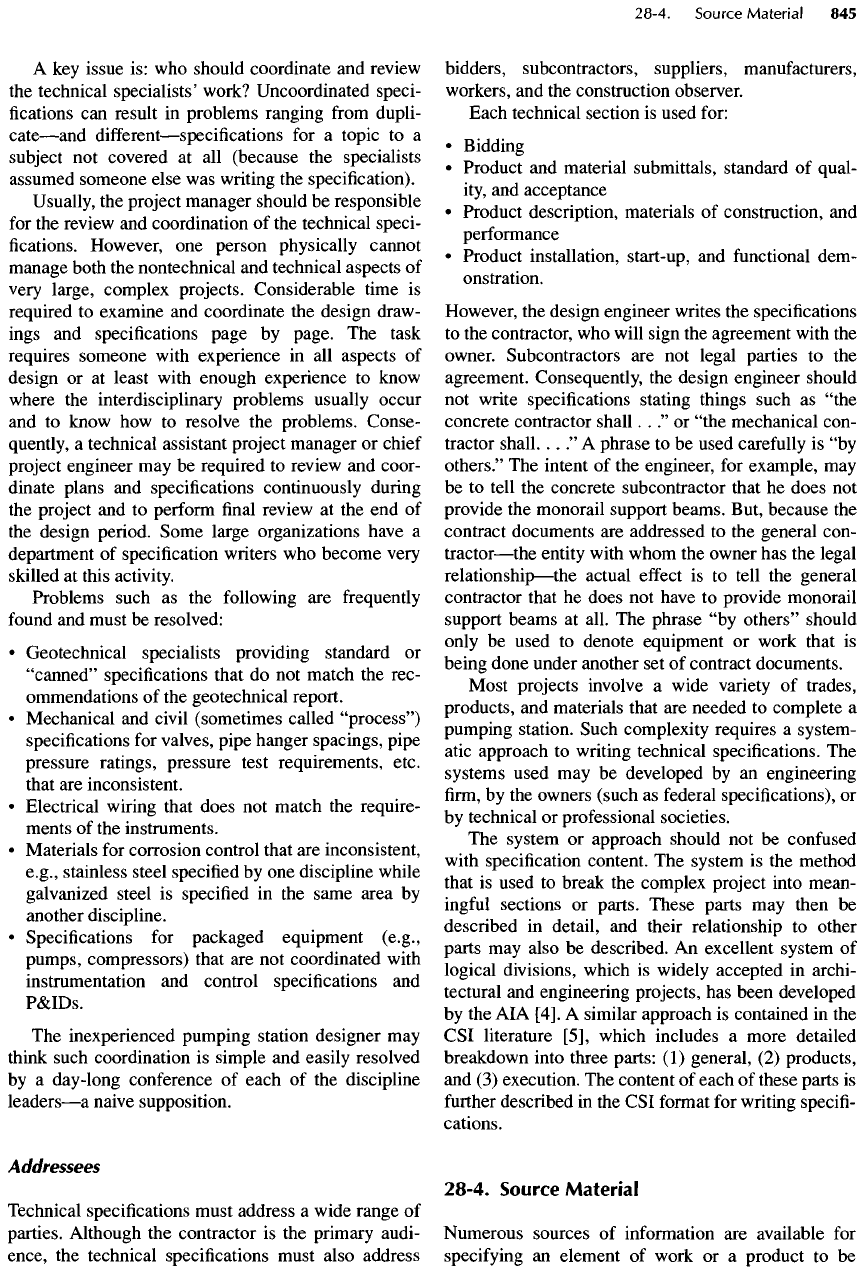
A
key
issue
is: who
should coordinate
and
review
the
technical
specialists'
work? Uncoordinated speci-
fications
can
result
in
problems ranging
from
dupli-
cate
—
and
different
—
specifications
for a
topic
to a
subject
not
covered
at all
(because
the
specialists
assumed
someone else
was
writing
the
specification).
Usually,
the
project manager should
be
responsible
for
the
review
and
coordination
of the
technical speci-
fications.
However,
one
person physically cannot
manage
both
the
nontechnical
and
technical aspects
of
very
large, complex projects. Considerable time
is
required
to
examine
and
coordinate
the
design draw-
ings
and
specifications page
by
page.
The
task
requires
someone with experience
in all
aspects
of
design
or at
least with enough experience
to
know
where
the
interdisciplinary problems usually occur
and
to
know
how to
resolve
the
problems. Conse-
quently,
a
technical assistant project manager
or
chief
project
engineer
may be
required
to
review
and
coor-
dinate plans
and
specifications continuously during
the
project
and to
perform
final
review
at the end of
the
design period. Some large organizations have
a
department
of
specification writers
who
become very
skilled
at
this activity.
Problems such
as the
following
are
frequently
found
and
must
be
resolved:
•
Geotechnical specialists providing standard
or
"canned"
specifications that
do not
match
the
rec-
ommendations
of the
geotechnical report.
•
Mechanical
and
civil (sometimes
called
"process")
specifications
for
valves, pipe hanger spacings, pipe
pressure ratings, pressure test requirements, etc.
that
are
inconsistent.
•
Electrical wiring that does
not
match
the
require-
ments
of the
instruments.
•
Materials
for
corrosion control that
are
inconsistent,
e.g., stainless steel specified
by one
discipline while
galvanized
steel
is
specified
in the
same area
by
another discipline.
•
Specifications
for
packaged equipment (e.g.,
pumps,
compressors)
that
are not
coordinated with
instrumentation
and
control specifications
and
P&IDs.
The
inexperienced pumping station designer
may
think
such coordination
is
simple
and
easily resolved
by
a
day-long conference
of
each
of the
discipline
leaders
—
a
naive supposition.
Addressees
Technical
specifications must address
a
wide range
of
parties. Although
the
contractor
is the
primary audi-
ence,
the
technical specifications must also address
bidders, subcontractors, suppliers, manufacturers,
workers,
and the
construction observer.
Each technical section
is
used for:
•
Bidding
•
Product
and
material submittals, standard
of
qual-
ity,
and
acceptance
•
Product description, materials
of
construction,
and
performance
•
Product installation, start-up,
and
functional
dem-
onstration.
However,
the
design engineer writes
the
specifications
to the
contractor,
who
will sign
the
agreement with
the
owner. Subcontractors
are not
legal parties
to the
agreement. Consequently,
the
design engineer should
not
write specifications stating things such
as
"the
concrete contractor
shall
.
.
."
or
"the mechanical con-
tractor shall.
. .
"A
phrase
to be
used
carefully
is "by
others."
The
intent
of the
engineer,
for
example,
may
be to
tell
the
concrete subcontractor that
he
does
not
provide
the
monorail support beams. But, because
the
contract documents
are
addressed
to the
general con-
tractor
—
the
entity with whom
the
owner
has the
legal
relationship
—
the
actual
effect
is to
tell
the
general
contractor that
he
does
not
have
to
provide monorail
support
beams
at
all.
The
phrase
"by
others"
should
only
be
used
to
denote equipment
or
work that
is
being done under another
set of
contract documents.
Most projects involve
a
wide variety
of
trades,
products,
and
materials that
are
needed
to
complete
a
pumping
station. Such complexity requires
a
system-
atic approach
to
writing technical specifications.
The
systems
used
may be
developed
by an
engineering
firm,
by
the
owners (such
as
federal specifications),
or
by
technical
or
professional societies.
The
system
or
approach should
not be
confused
with
specification content.
The
system
is the
method
that
is
used
to
break
the
complex project into mean-
ingful
sections
or
parts. These parts
may
then
be
described
in
detail,
and
their relationship
to
other
parts
may
also
be
described.
An
excellent
system
of
logical divisions, which
is
widely accepted
in
archi-
tectural
and
engineering projects,
has
been developed
by
the AIA
[4].
A
similar approach
is
contained
in the
CSI
literature [5], which includes
a
more detailed
breakdown
into three parts:
(1)
general,
(2)
products,
and
(3)
execution.
The
content
of
each
of
these parts
is
further
described
in the CSI
format
for
writing
specifi-
cations.
28-4. Source
Material
Numerous
sources
of
information
are
available
for
specifying
an
element
of
work
or a
product
to be
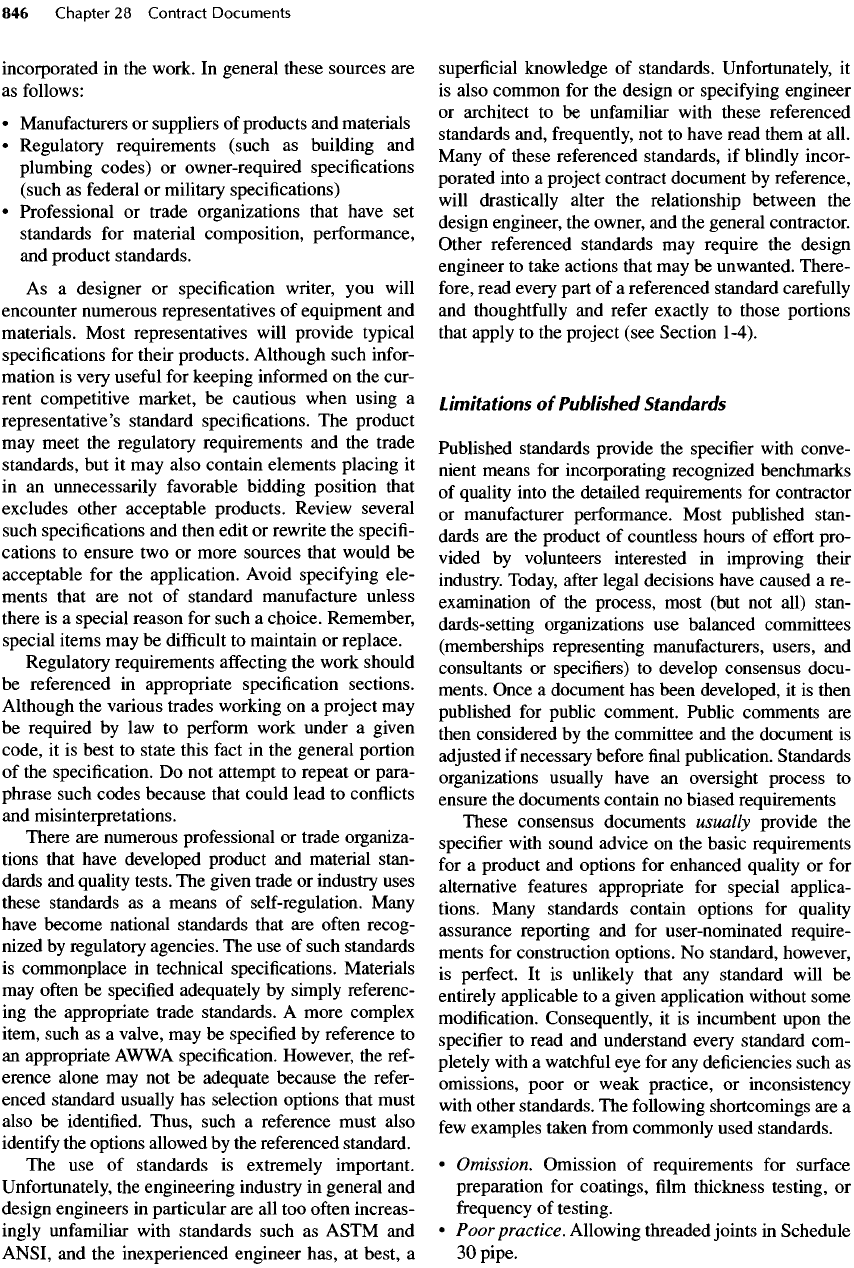
incorporated
in the
work.
In
general these sources
are
as
follows:
•
Manufacturers
or
suppliers
of
products
and
materials
•
Regulatory requirements (such
as
building
and
plumbing
codes)
or
owner-required specifications
(such
as
federal
or
military specifications)
•
Professional
or
trade organizations that have
set
standards
for
material composition, performance,
and
product standards.
As
a
designer
or
specification writer,
you
will
encounter numerous representatives
of
equipment
and
materials. Most representatives will provide typical
specifications
for
their
products. Although such infor-
mation
is
very
useful
for
keeping informed
on the
cur-
rent competitive market,
be
cautious when using
a
representative's standard specifications.
The
product
may
meet
the
regulatory requirements
and the
trade
standards,
but it may
also contain elements placing
it
in
an
unnecessarily favorable bidding position that
excludes other acceptable products. Review several
such
specifications
and
then edit
or
rewrite
the
specifi-
cations
to
ensure
two or
more sources that would
be
acceptable
for the
application. Avoid specifying ele-
ments that
are not of
standard manufacture unless
there
is a
special reason
for
such
a
choice. Remember,
special items
may be
difficult
to
maintain
or
replace.
Regulatory requirements
affecting
the
work should
be
referenced
in
appropriate specification sections.
Although
the
various trades working
on a
project
may
be
required
by law to
perform work under
a
given
code,
it is
best
to
state this
fact
in the
general portion
of
the
specification.
Do not
attempt
to
repeat
or
para-
phrase such codes because that could lead
to
conflicts
and
misinterpretations.
There
are
numerous professional
or
trade organiza-
tions that have developed product
and
material stan-
dards
and
quality tests.
The
given trade
or
industry uses
these standards
as a
means
of
self-regulation. Many
have
become national standards that
are
often
recog-
nized
by
regulatory agencies.
The use of
such standards
is
commonplace
in
technical specifications. Materials
may
often
be
specified adequately
by
simply referenc-
ing
the
appropriate trade standards.
A
more complex
item, such
as a
valve,
may be
specified
by
reference
to
an
appropriate
AWWA
specification. However,
the
ref-
erence
alone
may not be
adequate because
the
refer-
enced standard usually
has
selection options that must
also
be
identified.
Thus, such
a
reference must also
identify
the
options allowed
by the
referenced standard.
The use of
standards
is
extremely important.
Unfortunately,
the
engineering industry
in
general
and
design engineers
in
particular
are all too
often
increas-
ingly
unfamiliar with standards such
as
ASTM
and
ANSI,
and the
inexperienced engineer has,
at
best,
a
superficial
knowledge
of
standards. Unfortunately,
it
is
also common
for the
design
or
specifying engineer
or
architect
to be
unfamiliar with these referenced
standards and, frequently,
not to
have read them
at
all.
Many
of
these referenced standards,
if
blindly incor-
porated into
a
project contract document
by
reference,
will drastically alter
the
relationship between
the
design engineer,
the
owner,
and the
general contractor.
Other referenced standards
may
require
the
design
engineer
to
take actions that
may be
unwanted. There-
fore,
read every part
of a
referenced standard carefully
and
thoughtfully
and
refer exactly
to
those portions
that
apply
to the
project (see Section
1-4).
Limitations
of
Published
Standards
Published standards provide
the
specifier
with conve-
nient means
for
incorporating recognized benchmarks
of
quality into
the
detailed
requirements
for
contractor
or
manufacturer performance. Most published stan-
dards
are the
product
of
countless hours
of
effort
pro-
vided
by
volunteers interested
in
improving their
industry.
Today,
after
legal decisions have caused
a re-
examination
of the
process, most (but
not
all) stan-
dards-setting organizations
use
balanced committees
(memberships representing manufacturers, users,
and
consultants
or
specifiers)
to
develop consensus docu-
ments. Once
a
document
has
been developed,
it is
then
published
for
public comment. Public comments
are
then
considered
by the
committee
and the
document
is
adjusted
if
necessary before
final
publication. Standards
organizations usually have
an
oversight process
to
ensure
the
documents contain
no
biased requirements
These
consensus documents
usually
provide
the
specifier
with sound advice
on the
basic requirements
for
a
product
and
options
for
enhanced quality
or for
alternative features appropriate
for
special applica-
tions.
Many standards contain options
for
quality
assurance reporting
and for
user-nominated require-
ments
for
construction options.
No
standard, however,
is
perfect.
It is
unlikely that
any
standard will
be
entirely applicable
to a
given application without some
modification.
Consequently,
it is
incumbent upon
the
specifier
to
read
and
understand every standard com-
pletely with
a
watchful
eye for any
deficiencies such
as
omissions, poor
or
weak practice,
or
inconsistency
with
other standards.
The
following shortcomings
are a
few
examples taken
from
commonly used standards.
•
Omission. Omission
of
requirements
for
surface
preparation
for
coatings,
film
thickness testing,
or
frequency
of
testing.
•
Poor practice. Allowing threaded joints
in
Schedule
30
pipe.
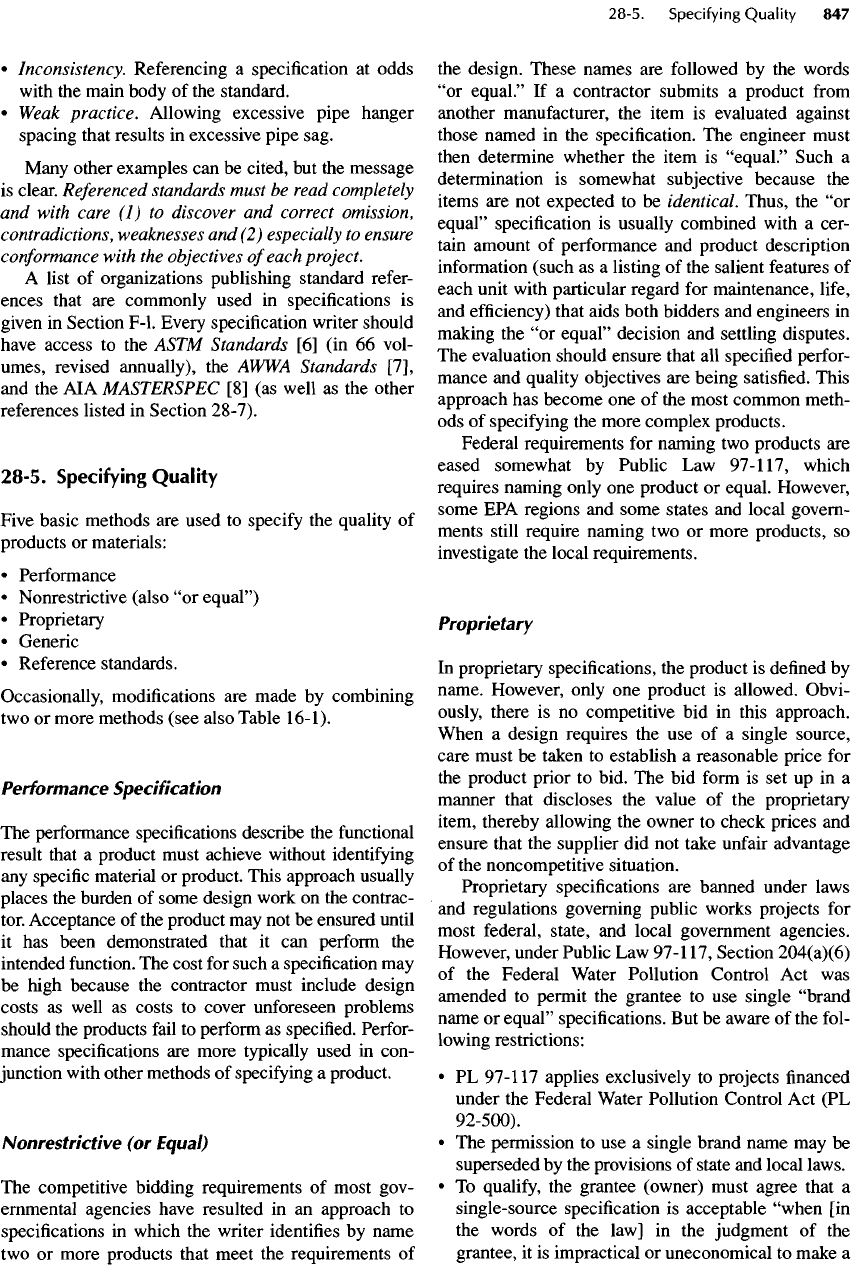
•
Inconsistency. Referencing
a
specification
at
odds
with
the
main body
of the
standard.
•
Weak
practice. Allowing excessive pipe hanger
spacing
that results
in
excessive pipe sag.
Many
other examples
can be
cited,
but the
message
is
clear.
Referenced
standards
must
be
read
completely
and
with
care
(1)
to
discover
and
correct omission,
contradictions,
weaknesses
and (2)
especially
to
ensure
conformance
with
the
objectives
of
each
project.
A
list
of
organizations publishing standard refer-
ences that
are
commonly used
in
specifications
is
given
in
Section
F-I.
Every specification writer should
have
access
to the
ASTM
Standards
[6] (in 66
vol-
umes,
revised annually),
the
AVFWft
Standards [7],
and
the AIA
MASTERSPEC
[8] (as
well
as the
other
references
listed
in
Section 28-7).
28-5.
Specifying
Quality
Five basic methods
are
used
to
specify
the
quality
of
products
or
materials:
•
Performance
•
Nonrestrictive (also
"or
equal")
•
Proprietary
•
Generic
•
Reference standards.
Occasionally, modifications
are
made
by
combining
two
or
more methods (see also Table
16-1).
Performance
Specification
The
performance specifications describe
the
functional
result
that
a
product must achieve without identifying
any
specific
material
or
product. This approach usually
places
the
burden
of
some design work
on the
contrac-
tor.
Acceptance
of the
product
may not be
ensured until
it
has
been demonstrated that
it can
perform
the
intended
function.
The
cost
for
such
a
specification
may
be
high because
the
contractor must include design
costs
as
well
as
costs
to
cover unforeseen problems
should
the
products
fail
to
perform
as
specified. Perfor-
mance specifications
are
more typically used
in
con-
junction with other methods
of
specifying
a
product.
Nonrestrictive
(or
Equal)
The
competitive bidding requirements
of
most gov-
ernmental
agencies have resulted
in an
approach
to
specifications
in
which
the
writer identifies
by
name
two
or
more products that meet
the
requirements
of
the
design. These names
are
followed
by the
words
"or
equal."
If a
contractor submits
a
product
from
another manufacturer,
the
item
is
evaluated against
those named
in the
specification.
The
engineer must
then determine whether
the
item
is
"equal."
Such
a
determination
is
somewhat subjective because
the
items
are not
expected
to be
identical. Thus,
the "or
equal"
specification
is
usually combined with
a
cer-
tain amount
of
performance
and
product description
information
(such
as a
listing
of the
salient features
of
each unit with particular regard
for
maintenance, life,
and
efficiency)
that aids both bidders
and
engineers
in
making
the "or
equal" decision
and
settling disputes.
The
evaluation should ensure that
all
specified perfor-
mance
and
quality objectives
are
being satisfied. This
approach
has
become
one of the
most common meth-
ods of
specifying
the
more complex products.
Federal requirements
for
naming
two
products
are
eased somewhat
by
Public
Law
97-117,
which
requires naming only
one
product
or
equal. However,
some
EPA
regions
and
some states
and
local govern-
ments still require naming
two or
more products,
so
investigate
the
local requirements.
Proprietary
In
proprietary specifications,
the
product
is
defined
by
name. However, only
one
product
is
allowed. Obvi-
ously,
there
is no
competitive
bid in
this approach.
When
a
design requires
the use of a
single source,
care must
be
taken
to
establish
a
reasonable price
for
the
product prior
to
bid.
The bid
form
is set up in a
manner that
discloses
the
value
of the
proprietary
item, thereby allowing
the
owner
to
check prices
and
ensure that
the
supplier
did not
take
unfair
advantage
of
the
noncompetitive situation.
Proprietary specifications
are
banned under laws
and
regulations governing public works projects
for
most
federal, state,
and
local government agencies.
However, under Public
Law
97-1
17,
Section 204(a)(6)
of
the
Federal Water Pollution Control
Act was
amended
to
permit
the
grantee
to use
single "brand
name
or
equal"
specifications.
But be
aware
of the
fol-
lowing
restrictions:
• PL
97-117
applies exclusively
to
projects
financed
under
the
Federal Water Pollution Control
Act (PL
92-500).
• The
permission
to use a
single brand name
may be
superseded
by the
provisions
of
state
and
local laws.
• To
qualify,
the
grantee (owner) must agree that
a
single-source specification
is
acceptable "when
[in
the
words
of the
law]
in the
judgment
of the
grantee,
it is
impractical
or
uneconomical
to
make
a
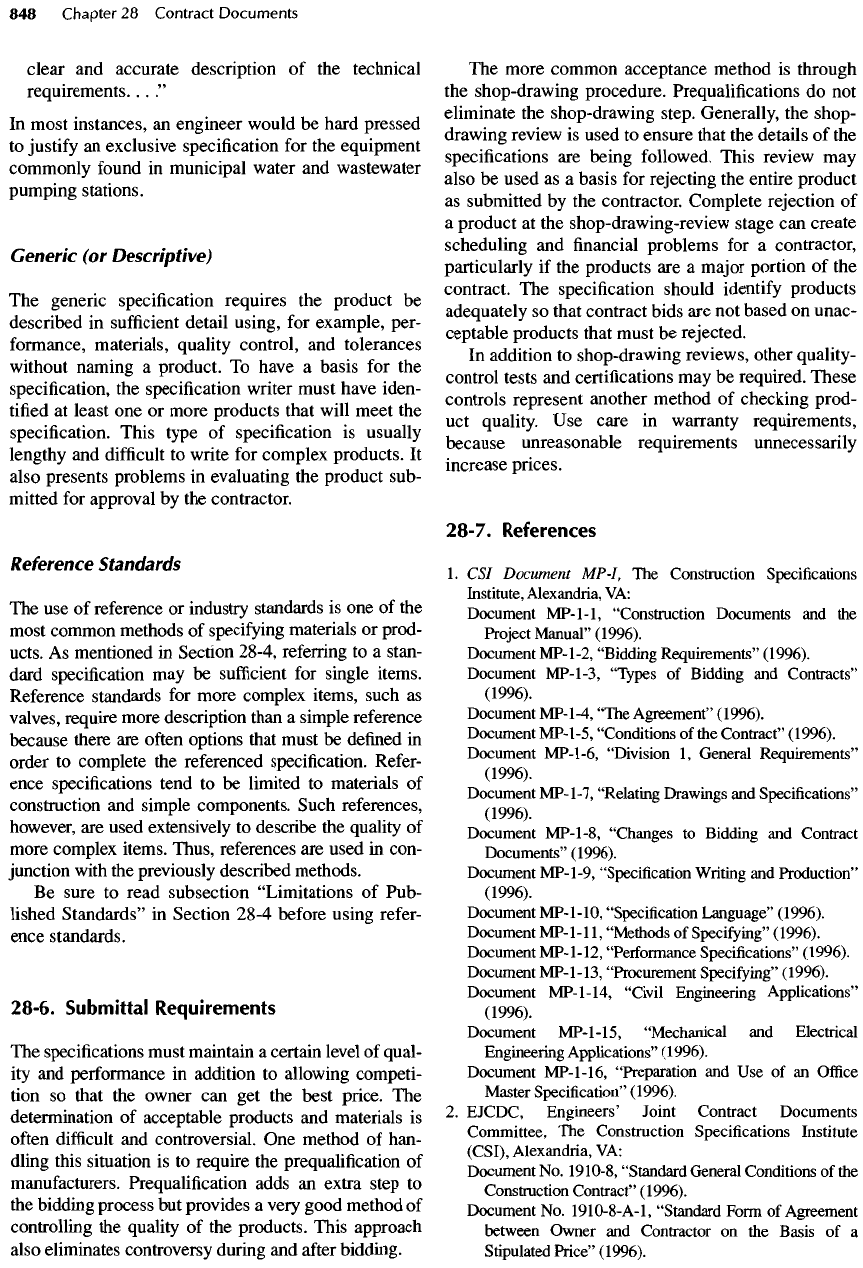
clear
and
accurate description
of the
technical
requirements.
..."
In
most instances,
an
engineer would
be
hard pressed
to
justify
an
exclusive specification
for the
equipment
commonly
found
in
municipal water
and
wastewater
pumping
stations.
Generic
(or
Descriptive)
The
generic specification requires
the
product
be
described
in
sufficient
detail using,
for
example, per-
formance,
materials, quality control,
and
tolerances
without naming
a
product.
To
have
a
basis
for the
specification,
the
specification writer must have iden-
tified
at
least
one or
more products that will meet
the
specification.
This type
of
specification
is
usually
lengthy
and
difficult
to
write
for
complex products.
It
also presents problems
in
evaluating
the
product sub-
mitted
for
approval
by the
contractor.
Reference
Standards
The use of
reference
or
industry standards
is one of the
most
common methods
of
specifying
materials
or
prod-
ucts.
As
mentioned
in
Section 28-4, referring
to a
stan-
dard
specification
may be
sufficient
for
single items.
Reference
standards
for
more complex items, such
as
valves,
require more description than
a
simple reference
because there
are
often
options that must
be
defined
in
order
to
complete
the
referenced specification.
Refer-
ence specifications tend
to be
limited
to
materials
of
construction
and
simple components. Such references,
however,
are
used extensively
to
describe
the
quality
of
more complex items. Thus, references
are
used
in
con-
junction
with
the
previously described methods.
Be
sure
to
read subsection "Limitations
of
Pub-
lished Standards"
in
Section 28-4 before using refer-
ence standards.
28-6.
Submittal
Requirements
The
specifications must maintain
a
certain level
of
qual-
ity
and
performance
in
addition
to
allowing competi-
tion
so
that
the
owner
can get the
best price.
The
determination
of
acceptable products
and
materials
is
often
difficult
and
controversial.
One
method
of
han-
dling
this situation
is to
require
the
prequalification
of
manufacturers.
Prequalification adds
an
extra step
to
the
bidding process
but
provides
a
very good method
of
controlling
the
quality
of the
products. This approach
also eliminates controversy during
and
after
bidding.
The
more common acceptance method
is
through
the
shop-drawing procedure.
Prequalifications
do not
eliminate
the
shop-drawing step. Generally,
the
shop-
drawing review
is
used
to
ensure that
the
details
of the
specifications
are
being followed. This review
may
also
be
used
as a
basis
for
rejecting
the
entire product
as
submitted
by the
contractor. Complete rejection
of
a
product
at the
shop-drawing-review stage
can
create
scheduling
and financial
problems
for a
contractor,
particularly
if the
products
are a
major
portion
of the
contract.
The
specification should
identify
products
adequately
so
that contract bids
are not
based
on
unac-
ceptable products that must
be
rejected.
In
addition
to
shop-drawing reviews, other quality-
control tests
and
certifications
may be
required. These
controls represent another method
of
checking prod-
uct
quality.
Use
care
in
warranty requirements,
because unreasonable requirements unnecessarily
increase prices.
28-7.
References
1. CSI
Document
MP-I,
The
Construction Specifications
Institute,
Alexandria,
VA:
Document
MP-
1-1,
"Construction
Documents
and the
Project
Manual"
(1996).
Document
MP-1-2,
"Bidding
Requirements"
(1996).
Document
MP-1-3,
"Types
of
Bidding
and
Contracts"
(1996).
Document
MP-1-4,
"The
Agreement"
(1996).
Document
MP-1-5,
"Conditions
of the
Contract"
(1996).
Document
MP-
1-6,
"Division
1,
General
Requirements"
(1996).
Document
MP-
1-7,
"Relating
Drawings
and
Specifications"
(1996).
Document
MP-
1-8,
"Changes
to
Bidding
and
Contract
Documents"
(1996).
Document
MP-
1-9,
"Specification
Writing
and
Production"
(1996).
Document
MP-1-10,
"Specification
Language"
(1996).
Document
MP-1-1
1,
"Methods
of
Specifying"
(1996).
Document
MP-1-12,
"Performance
Specifications"
(1996).
Document
MP-1-13,
"Procurement
Specifying"
(1996).
Document
MP-
1-14,
"Civil
Engineering
Applications"
(1996).
Document
MP-
1-15,
"Mechanical
and
Electrical
Engineering
Applications"
(1996).
Document
MP-
1-16,
"Preparation
and Use of an
Office
Master
Specification"
(1996).
2.
EJCDC,
Engineers'
Joint
Contract
Documents
Committee,
The
Construction
Specifications
Institute
(CSI),
Alexandria,
VA:
Document
No.
1910-8,
"Standard
General
Conditions
of the
Construction
Contract"
(1996).
Document
No.
1910-8-A-l,
"Standard
Form
of
Agreement
between
Owner
and
Contractor
on the
Basis
of a
Stipulated
Price"
(1996).
